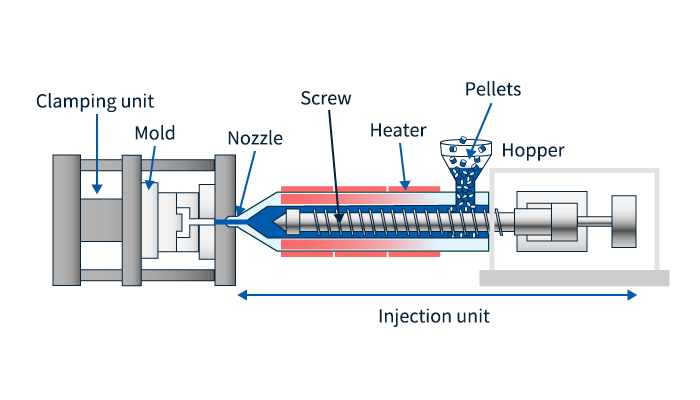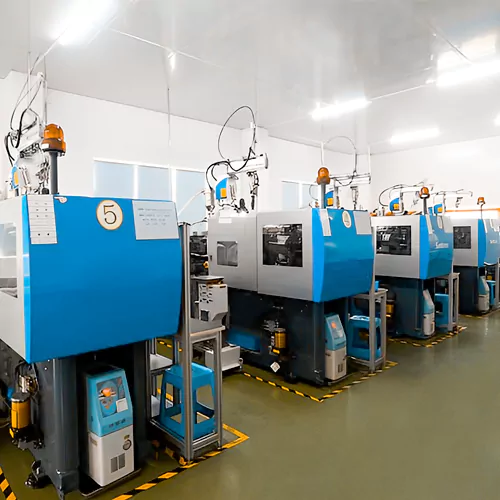Enhancing Item Growth with Advanced Plastic Injection Molding Solutions
Enhancing Item Growth with Advanced Plastic Injection Molding Solutions
Blog Article
Understanding the Basics of Plastic Injection Molding Procedures
Plastic shot molding works as a foundation of modern production, providing a systematic technique to generating complex parts with accuracy. This process not only incorporates the fundamental steps of melting and injecting materials into molds yet also entails a nuanced understanding of different affecting factors, such as temperature and stress. As markets significantly require effectiveness and high quality, the ins and outs of this technique end up being a lot more crucial. Checking out these crucial components could disclose how even small modifications can bring about significant improvements in production outcomes, questioning concerning the capacity for technology in this recognized procedure.
What Is Plastic Injection Molding?
Plastic shot molding is an extensively made use of manufacturing process that transforms thermoplastic and thermosetting materials right into specific and intricate forms. This strategy is favored for its ability to generate high volumes of identical get rid of exceptional precision, making it a vital method in different industries, consisting of auto, consumer items, and clinical devices.
The procedure entails melting the selected plastic material and infusing it right into a mold and mildew under high pressure. The mold and mildew, made to the specs of the preferred part, permits the liquified plastic to take form as it cools and solidifies. As soon as the material has actually solidified, the mold and mildew is opened up, and the completed part is ejected.
Plastic shot molding supplies several benefits, including lowered waste, consistency in production, and the ability to include detailed layouts that may be testing with other producing techniques. Furthermore, it sustains a wide series of products, each supplying special properties that can be customized for details applications. As industries remain to innovate, plastic injection molding continues to be at the center, making it possible for the advancement of innovative items that satisfy advancing consumer demands.
The Injection Molding Process
The injection molding process is a sophisticated strategy that entails a number of essential phases to produce high-quality plastic elements. Plastic pellets are fed right into a warmed barrel where they are melted right into a thick liquid. This molten plastic is then injected under high pressure right into a precision-engineered mold and mildew, which shapes the product right into the preferred kind.
When the mold and mildew is loaded, the plastic is enabled to solidify and cool, taking the shape of the mold cavity. Air conditioning time is essential, as it impacts the cycle time and the last buildings of the molded component. After adequate air conditioning, the mold and mildew opens, and the finished part is ejected using ejector pins.

Products Used in Shot Molding
Various materials can be utilized in the shot molding procedure, each offering distinct residential properties that provide to particular applications. One of the most generally utilized materials consist of thermoplastics, thermosetting plastics, and elastomers.

Thermosetting plastics, like epoxy and phenolic materials, go through a chemical change throughout the healing procedure, causing a stiff, inflexible structure. These materials are optimal for applications needing high warm resistance and structural honesty, typically utilized in browse around this site electric insulators and vehicle parts.
Elastomers, including silicone and rubber-based materials, offer flexibility and resilience. Their one-of-a-kind properties make them suitable for applications that require flexibility, such as gaskets and seals.
In addition, specialized materials like bio-based plastics and compounds are getting traction for their ecological benefits and improved performance attributes, widening the scope of injection molding applications in different industries. Understanding the buildings of these products is critical for choosing the ideal type for particular projects.
Benefits of Injection Molding
Injection molding stands apart as a highly reliable manufacturing procedure that uses numerous benefits for creating complicated get rid of precision. One of the most considerable benefits is the ability to create intricate designs that would be impossible or challenging to accomplish with other techniques (Plastic Injection Molding). The procedure allows for comprehensive features and tight tolerances, guaranteeing top notch parts
Additionally, injection molding is understood for its quick manufacturing abilities, making it a suitable choice for high-volume production. Once the mold and mildew is created, parts can be generated rapidly, reducing preparations and boosting general performance. This effectiveness not only reduces manufacturing costs however also provides a competitive edge in the market.
The versatility of products utilized in shot molding additionally enhances its appeal. A vast array of thermoplastics and thermosetting polymers can webpage be utilized, enabling suppliers to select products that best satisfy their details requirements, including adaptability, warm, and toughness resistance.
Moreover, the procedure decreases waste, as excess product can commonly be reused and recycled. This sustainability facet adds to a minimized ecological influence, making shot molding an accountable production selection. In general, the benefits of injection molding make it a favored approach for lots of sectors.
Elements Affecting Product Top Quality
While many aspects can influence item quality in shot molding, recognizing these aspects is vital for attaining optimal outcomes. Trick aspects include product choice, refining specifications, and mold design.
Product choice plays an essential function, as various polymers display distinct residential properties that influence flowability, stamina, and thermal security. Inadequate material choice can bring about problems such as warping or incomplete filling.
Handling criteria, consisting of cycle, pressure, and temperature level time, must be diligently controlled. Variations in these setups can result in inconsistencies in component dimensions and surface area finish. For example, excessively high temperature levels may create deterioration of the polymer, while inadequate stress can lead to brief shots.
Mold and mildew layout is similarly essential, as it identifies the circulation of the molten plastic and the cooling procedure. Poorly developed molds might lead to unequal cooling prices, leading to dimensional errors and residual stress and anxieties.

Verdict
Finally, plastic injection molding acts as an important production process that allows the reliable manufacturing of top quality parts. Proficiency of the shot molding procedure, including the understanding of materials and the impact of various aspects on product high quality, is crucial for attaining ideal outcomes. The benefits of this method, such as cost-effectiveness and style versatility, further underscore its significance throughout numerous sectors, strengthening its condition as a favored selection for high-volume manufacturing.
Plastic shot molding offers as a foundation of contemporary production, providing a systematic technique to generating intricate components with accuracy.Plastic shot molding offers numerous view publisher site advantages, including minimized waste, consistency in production, and the ability to incorporate intricate layouts that might be challenging with other manufacturing approaches (Plastic Injection Molding). As sectors continue to introduce, plastic shot molding continues to be at the forefront, enabling the advancement of sophisticated products that meet advancing consumer demands
The shot molding process is a sophisticated technique that includes a number of vital phases to produce top notch plastic parts.In conclusion, plastic shot molding offers as a vital production process that allows the reliable production of top notch parts.
Report this page